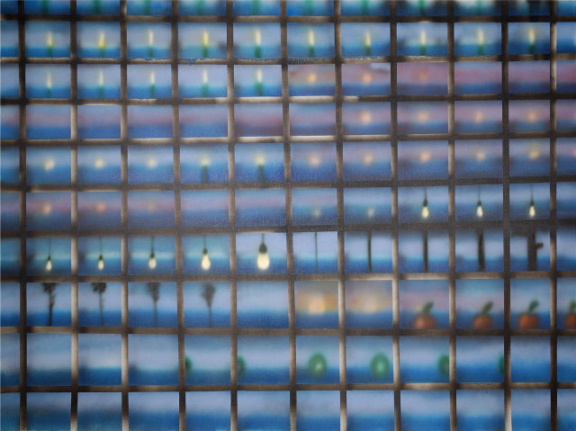
- 1976
- Canvas
- Cellulose paint
- Inv. 76P617
Luís Noronha da Costa
Untitled
Luís Noronha da Costa’s visual work has been produced on the basis of a creative dialogue with the nature of the image. Trained in architecture and passionate about films – which he also directed in an experimental way –, the artist began by exploring the possibilities offered by the semantic unfolding of the graphic language of current affairs magazines.* From there he proceeded to the construction of objects with mirrors that questioned the sense and meaning of sight itself. The series of objects, and specifically the series of blue objects from 1968, reveal a strong continuity, in terms of imagery, with the painting that he had produced in subsequent years. They already represented, in a fairly explicit manner, the idea of the screen, i.e., of a plane exterior to the painting, where, as a result of a deliberate spatial-temporal ambiguity, the created image seems to complete itself. This was an approach that would be essential to Noronha da Costa’s subsequent painting, and which he adopted as a working method.
The painting shown here belongs to the series of “landscape paintings with grids”, about which the painter would write «here the “grille” stops being a grille and an identification arises between the reading of the sections and the whole image. (…) What is amazing is that-space-is-created, but that WHEN- -SPACE-IS-CREATED (when time intervenes…) everything is on the same plane, and then the plane coincides with the screen».** The painting of the grid in the foreground, with areas of chiaroscuro, imposes the serialised sequence of images, which emerge like the frames of a film over the perception of the luminous shades emitted by different points of light.
The images of the objects superimposed on the background, which suggests a landscape, and which is sometimes also illuminated, comprise an iconographic repertoire on which the artist has worked a great deal: sails, electric light bulbs, trees, solar discs, fruits. The naturalism of the representation of the grid heightens the degree of artificiality of the image. Here, the cinematographic language has been worked on pictorially and the painter engages with the unfolding and verification of the space-time of the image. Other paintings featuring superimposed grids, or which introduce black in order to cover the plane of the painting, would follow this one, in a «sort of body of treatises on the image»*** that makes Noronha da Costa’s exploratory pictorial work a stimulating opportunity for reflection on the possibilities of the power of the image.
Ana Vasconcelos
May 2010
* With a series of compositions based on an “original ‘slide’ technique”, as José-Augusto França wrote, which simultaneously showed the front and back of magazine clippings soaked in linseed oil.
** Miguel Wandschneider and Nuno Faria, Noronha da Costa Revisitado (1965-1983), Porto / Lisbon, Edições ASA, Fundação CCB, 2003, p. 284.
*** Bernardo Pinto de Almeida, Noronha da Costa ou a consciência do tempo, Lisbon, Caminho, 2006, p. 26.
| Type | Value | Unit | Section |
| Height | 165 | cm | |
| Width | 220,5 | cm |
| Type | date |
| Type | signature |
| Type | Acquisition |
